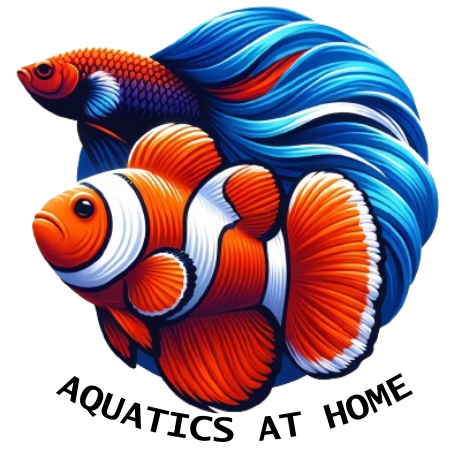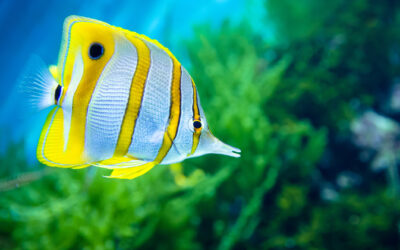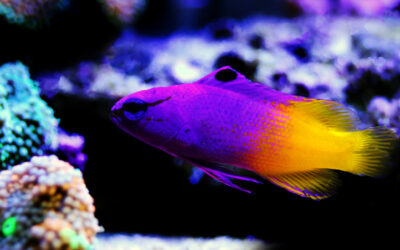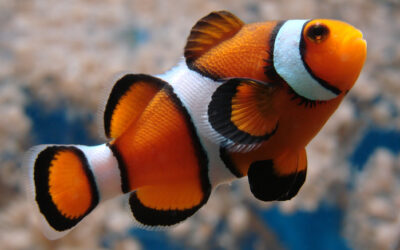If you’re in the market for an eye-catching, active fish that will shine in your aquarium, the Six Line Wrasse might be the perfect choice. Not only are they beautiful and fascinating to observe, but they’re also relatively hardy and easy to care for.

The six line wrasse is a zippy little fish that adds color and personality to most environments. Still, you will need to ensure they feel safe and comfortable in your aquarium. If they are comfortable, they can be an amazing contributor to your tank. My personal favorite thing about them is their sleeping habits – they sleep in the cutest little web! I have enjoyed six-line wrasses for years, and while I have only had a couple, that’s only because they thrived alongside my various clownfish, damsels, and soft corals. These are truly one of my favorites.
Since most people want to know before they even consider this fish, let’s answer a quick question:
Are Six Line Wrasses Reef Safe?
Yes, six-line wrasses are safe to live with corals. They are considered reef-safe as they generally do not bother corals and can actually benefit a reef aquarium by feeding on parasitic pests such as bristle worms, flatworms, and pyramidal snails. Regardless of the general rule, as with any aquarium inhabitant, the specific temperament of the individual fish and the dynamics of your tank should be considered. You never know if you are going to get the exception to the rule – so watch them closely when you introduce them to your tank!
…ok back to the good stuff – In this comprehensive guide, we’ll cover everything you need to know about keeping Six Line Wrasses healthy and happy in your aquarium.
Introduction to the Six Line Wrasse
The Six Line Wrasse is a staple member of many saltwater fish tank communities not only for its looks – this is a functional worker within the tank. This little Wrasse is known to eat flatworms and certain small, common nuisances and pests. As you introduce coral, live rock, and other inhabitants into your tank, you will inevitably introduce a host of both beneficial community members (like copepods) and less beloved community members (like bristleworms). When kept in check, most pests are of little consequence to your tank, but you can only do so much – that’s why a wonderful fish like a six-line wrasse gives you an advantage in maintaining stability.
The Six Line Wrasse is native to the Indo-Pacific, where it inhabits coral reefs and rocky areas. These fish belong to the family Labridae, which is one of the biggest families of marine fishes. They are also known by other names, such as Six Stripe Wrasse, Sixline Wrasse, and Rainbow Wrasse, due to their stunning colors and distinctive markings.
Species Overview
The Six Line Wrasse (Pseudocheilinus hexataenia) is one of the smaller members of the Labridae family, growing to a maximum length of about 4 inches. Most local fish stores (lfs) sell them at 3/4″ to about 1.5″ in size, so make sure if you have semi-aggressive community fish, your damsel is at least faster, similar in size, and/or has plenty of space to hide. Despite their small size, they are incredibly active and have a lot of personality. They are slender and have elongated bodies, with six horizontal stripes running lengthwise along their sides. 
The front portion of their body is covered in fine scales, while the back half is covered in larger, diamond-shaped scales. We will talk all about their vibrant colors and stripes in a couple paragraphs.
Natural Habitat and Distribution
Six Line Wrasses can be found in a range of reef environments throughout the Indo-Pacific, from the Red Sea and East Africa to Micronesia and Hawaii. They prefer coral-rich habitats with plenty of hiding spots and rubble for cover. In the wild, they can be found darting in and out of crevices and caves, searching for small invertebrates to eat.
Suppose you’re planning to keep a Six Line Wrasse in your aquarium. In that case, providing them with a similar environment is crucial. This means creating plenty of hiding spots with live rock and coral and ensuring the water quality is consistently good.
Physical Characteristics and Behavior
It only takes one look to see why they are renowned for their vibrant colors, consisting predominantly of a brilliant cobalt-blue body with six distinct orange-red stripes running longitudinally from head to tail. Its eyes are accented with two bright lines, which often makes the wrasse look like it’s squinting menacingly at you when it inspects your face near the tank. The fish’s fins are multifaceted, with its caudal fin being green, often with a dot punctuating the top of the fin near the base by the body, its dorsal and ventral fins showing translucent qualities, and its pectoral fins, primarily clear, all of which are adorned with thin, electric blue lines that enhance its striking appearance. Their large, almond-shaped eyes and small and pointed mouths are designed for picking small invertebrates off rocks and coral.
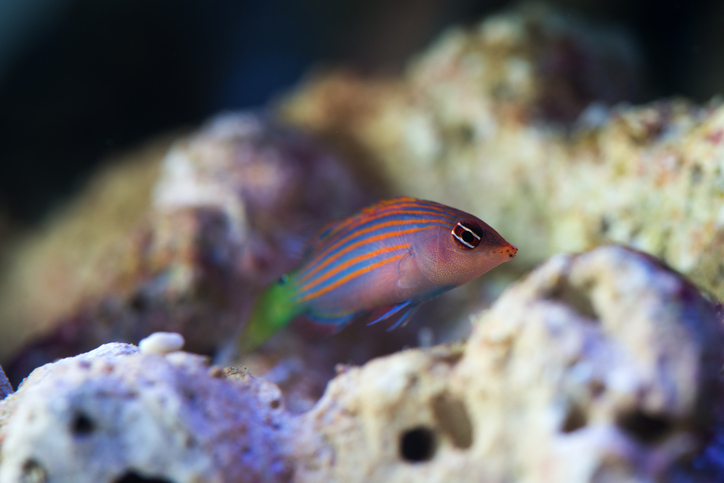
These fish are very active and are constantly in motion (until they sleep in their little web!), darting from hiding spot to hiding spot and exploring their surroundings. They can be a bit skittish, so it’s best to keep them in an aquarium with plenty of hiding spots. They are also known to be aggressive towards other fish of the same species, so it’s best to keep only one Six Line Wrasse in a tank.
Setting Up the Ideal Aquarium Environment
Setting up an aquarium for Six Line Wrasses requires careful consideration of a few key factors. These fish are active and require plenty of space to swim, as well as adequate lighting and water flow. Additionally, providing hiding spots and suitable substrate is important to keep them healthy and happy.
Tank Size and Requirements
Six Line Wrasses need plenty of swimming space to thrive. While they can be kept in smaller aquariums, they do best in tanks of at least 30 gallons. This allows for plenty of open swimming space and ample room for live rock or coral to provide hiding spots and shelter.
Do not overstock your tank – consider the other community fish. The general rule is one inch of fish maximum size per two gallons in a saltwater tank. That means you need 8 gallons for this little swimmer, and in a 30-gallon tank, you can get 3 more fish. Overstocking the tank can shorten the lifespan of your underwater friends, so please try to give them the appropriate amount of room to thrive – they will thank you every day for their long, happy lives.
In addition to swimming space, they also require adequate lighting and water flow. This can be achieved through the use of high-quality LED lights and a suitable powerhead or wave maker. These will benefit any reef tank but will give your fish the necessary variety even if you go the FOWLR (fish only with live rock) route.
Water Parameters and Filtration
As hardy fish, Six Line Wrasses can tolerate a range of water conditions. However, maintaining stable water parameters is important to keep them healthy and thriving. Ideal water conditions for Six Line Wrasses include a temperature range of 76-82 degrees Fahrenheit, a pH of 8.1-8.4, and a specific gravity of 1.023-1.025.
In addition to monitoring water parameters, try to use proper filtration such as a sump, biofilter, protein skimmer, or frequent water changes. This will help to keep the water clean and free of toxins, which is essential for the health of the fish. A suitable filtration system should be efficient enough to keep the water clean but not so strong that it creates too much water flow in the tank.
Substrate and Hiding Spots
Six Line Wrasses are known for their love of hiding spots, and providing ample hiding spots is essential to keep them happy and healthy. In addition, to live rock and coral, Six Line Wrasses also enjoy burrowing in sand beds to hide or sleep (how cute). A suitable substrate, such as fine sand or crushed coral, should be provided to allow them to engage in this natural behavior. Here is an example of a tank that allowed my Wrasse to live well with plenty of room to hide.
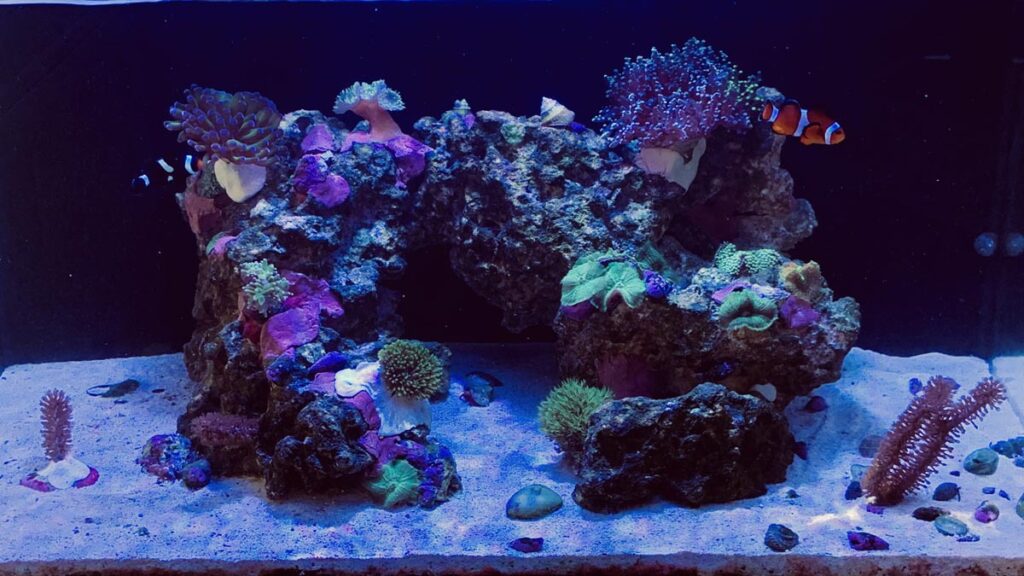
When planning an aquarium to accommodate a Six Line Wrasse, its hiding spots and shelter can include live rock, coral rubble, and other decorations. Creating a natural-looking environment that mimics the fish’s natural habitat will help to reduce stress and promote overall health and well-being.
By carefully considering the needs of Six Line Wrasses and providing a suitable aquarium environment, these fish can thrive and provide years of enjoyment for their owners. With proper care and attention, they are a beautiful and rewarding addition to any aquarium.
Diet and Feeding
Six Line Wrasses need a healthy and balanced diet to maintain their vibrant colors and dynamic behavior. In this section, we will explore the nutritional needs of the Six Line Wrasse, the types of food they should be fed, and tips for encouraging healthy eating habits.
Nutritional Needs of the Six Line Wrasse
As mentioned earlier, Six Line Wrasses are carnivores that feed on small crustaceans, worms, and other invertebrates in the wild. In captivity, you should provide a varied diet that includes frozen or live brine shrimp, krill, mysis shrimp, and other small meaty foods. This will ensure that they receive all the necessary nutrients for optimal health.
Some of the essential nutrients that Six Line Wrasses require include protein, fat, vitamins, and minerals. Protein is especially important for their growth and development, while fat provides energy and helps with digestion. Vitamins and minerals are necessary for maintaining their overall health and immune system. If you are feeding them a mix of foods, as mentioned above, this mix should naturally be met.
Types of Food and Feeding Schedule
When it comes to feeding Six Line Wrasses, follow a feeding schedule that provides small amounts of food multiple times a day. This will help prevent overfeeding and ensure that they have a steady supply of food throughout the day. You can feed them 1-2 times a day, with a small amount of food each time. Their stomach is about the size of their eye, so while you are frequently feeding them, remember they don’t need much in each feeding, and they snack all day on the teeny tiny pests in your tank (if you have them, which, you likely do).
As for the types of food, Six Line Wrasses enjoy a varied diet that includes frozen or live brine shrimp, krill, mysis shrimp, and other small meaty foods. You can also offer them small pieces of seafood like shrimp or squid. It’s important to observe their eating habits to ensure that they’re successfully eating and digesting their food.
Tips for Encouraging Healthy Eating Habits
If your Six Line Wrasse is hesitant to eat, you can try a few things to encourage healthy eating habits. First, try offering a variety of different foods until you find something that they like. You can also try soaking their food in a nutritional additive or garlic extract to entice them to eat.
Another tip is to create a feeding station in your tank. This can be a small dish or container that you place in the tank and fill with food. The Six Line Wrasse will quickly learn to associate the feeding station with food and will come to it when hungry.
Finally, make sure to clean up any uneaten food in the tank to prevent it from decomposing and causing water quality issues. With a little patience and effort, you can ensure that your Six Line Wrasse is receiving the best possible nutrition and staying healthy and active for years to come.
Tank Mates and Compatibility
Suitable Tank Mates for the Six Line Wrasse
Six Line Wrasses are somewhat peaceful fish that get along well with other non-aggressive species. In fact, they can be housed with a variety of compatible tank mates that will make for a lively and diverse aquarium community.
Other wrasses do not make great tank mates for the Six Line Wrasse. Unfortunately, these beauties can be little bullies to their own species (and fish that look similar), so it isn’t a bad idea to have only one Wrasse in the tank. I had consistent success with clownfish, certain gobies, and damselfish.
So, gobies and blennies are great choices for tank mates, provided the Wrasse doesn’t bully them. These small, bottom-dwelling fish are non-aggressive and will not compete with the Six Line Wrasse for food or territory.
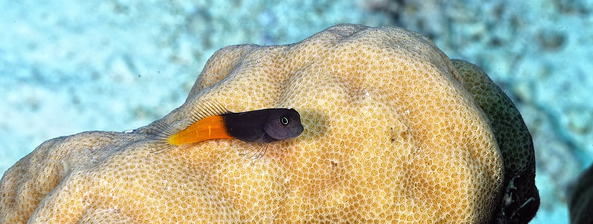
Small angelfish, such as the Flame Angelfish or the Coral Beauty Angelfish, can also be housed with the Six Line Wrasse if the tank is big enough, but you will want lots of space so they can enjoy their own territory. These fish are known for their bright colors and interesting patterns and will add a lot of visual interest to the aquarium.
The best fish, in my opinion, is either the ocellaris or percula clownfish. A mated clownfish pair will keep to themselves as your Wrasse zips to and fro. Since both fish have fun and different swimming habits, it will be fun to watch them dance about your tank.
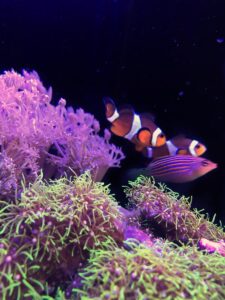
Regardless of what fish join your six line, make sure to provide enough space and hiding spots to prevent aggression and territorial disputes. A well-decorated aquarium with plenty of live rock and coral will provide ample hiding spots for all of the fish in the community.
Species to Avoid
While Six Line Wrasses are generally peaceful fish, there are certain species that should be avoided as tank mates. As previously mentioned, Six Line Wrasses may become aggressive towards some other members of the same species, so it’s best to keep just one in a tank. They may also be aggressive towards small, timid fish, such as certain species of clownfish, so it’s important to research potential tank mates before introducing them to the tank. If your clownfish are of similar size to your Wrasse when you introduce them into the tank, you may mitigate much of the bullying.
Additionally, avoid housing the Six Line Wrasse with any large, aggressive fish. These fish may see the Six Line Wrasse as prey and may attack it. Examples of fish to avoid include large groupers, lionfish, and triggerfish. I had a particularly small six line wrasse once and had to rehome the poor little one since he was so scared of the larger clownfish in the tank – just watch how your fish interact whenever introducing something new. Everyone with experience has a story of fish that are compatible despite reading horror stories, and they also have a story of compatible fish not getting along. Always treat these things on a case-by-case basis.
Tips for Introducing New Tank Mates
When adding new fish to the tank, it’s important to take the necessary steps to ensure that they will be healthy and happy in their new environment. This includes quarantining new fish for a period of time to ensure that they’re healthy and disease-free. Quarantining new fish can help prevent the spread of disease to other fish in the aquarium.
It’s also a good idea to slowly acclimate new fish to the new environment. This can be done by drip-acclimating them over an hour or two. Drip acclimation involves slowly adding water from the aquarium to the bag or bowl that the new fish is in. This allows the fish to slowly adjust to the new water conditions without being shocked by sudden temperature or water chemistry changes.
By choosing compatible tank mates and introducing them properly, you can create a thriving and diverse aquarium community that will bring you joy for years to come.
Breeding and Reproduction
Six Line Wrasses are unfortunately not known for breeding well in captivity. Apparently, it has been done, but it isn’t experienced too often.
Identifying Male and Female Six-Line Wrasses
As mentioned, it can be difficult to determine the sex of Six Line Wrasses. However, there are some subtle differences that can help with identification. Males tend to be slightly larger and have more elongated dorsal fins, while females have a rounder belly and may appear more plump during breeding season.
Observing the behavior of the fish can also provide clues to their sex. During the breeding season, males will become more territorial and aggressive towards other fish while also engaging in elaborate courtship displays to attract females. Since we recommend only having one Wrasse in the tank, this may not be something you will notice.
Common Health Issues and Prevention
Six Line Wrasses are a popular choice among saltwater aquarium enthusiasts due to their striking appearance and active personalities. These fish are generally hardy, but like all living creatures, they are susceptible to certain health issues. By understanding the signs of illness and taking preventative measures, you can help keep your Six Line Wrasses healthy and happy.
Signs of Illness in Six Line Wrasses
It’s important to keep a close eye on your Six Line Wrasses to catch any signs of illness early on. Common signs of illness in these fish include:
- Lethargy: If your fish is spending more time hiding or resting than swimming around, it could be a sign of illness.
- Loss of appetite: A decrease in appetite or refusal to eat altogether is another common sign of illness in Six Line Wrasses.
- Labored breathing: If your fish is breathing rapidly or seems to be struggling to breathe, it could be a sign of a respiratory issue.
- Skin lesions: Look for any unusual marks or lesions on your fish’s skin. These could be a sign of a bacterial or fungal infection.
Treatment and Prevention of Common Diseases
The best way to prevent illness in Six Line Wrasses is to maintain good water quality and provide a diverse, nutritious diet. This will help boost your fish’s immune system and reduce the risk of disease. If your fish does become sick, treatment options may include:
- Quarantining the fish: This will help prevent the spread of disease to other fish in the tank.
- Administering medication: Your veterinarian may prescribe medication to treat the specific illness your fish is experiencing.
- Adjusting tank conditions: In some cases, adjusting the temperature, salinity, or other tank conditions can help alleviate illness symptoms.
Maintaining Optimal Water Quality and Tank Conditions
Regular maintenance and monitoring of water quality are essential to keeping Six Line Wrasses healthy. This includes:
- Regular water changes: Aim to change 10-20% of the water in your tank every two weeks. I used to change 10-25% of the water weekly just to be safe.
- Testing of water parameters: Use a water testing kit to monitor levels of salinity, ammonia, nitrite, nitrate, pH, and other important parameters.
- Cleaning of filters and other equipment: Regularly clean your tank’s filter, protein skimmer, and other equipment to prevent the buildup of harmful bacteria and other contaminants.
It’s also important to monitor the behavior and eating habits of your fish to catch any potential health issues early on. By providing a clean, healthy environment and paying close attention to your Six Line Wrasses, you can help ensure they live long, happy lives in your aquarium.
Conclusion: Ensuring a Happy and Healthy Six-Line Wrasse
Regular Maintenance and Monitoring
Caring for Six Line Wrasses may seem daunting, but with the right setup and care, they can thrive in your home aquarium. Regular maintenance and monitoring of water quality and tank conditions are key to ensuring their health and happiness.
Ongoing Education and Resources
There’s always more to learn about caring for Six Line Wrasses and other marine life. Reach out to experienced fishkeepers and consult reliable resources to continue expanding your knowledge of fish care.
Enjoying Your Six Line Wrasse for Years to Come
With their colorful appearance and active personalities, Six Line Wrasses can be a fascinating addition to your home aquarium. With proper care, you can enjoy the beauty and charm of these fish for years to come.

About the Author
With decades of experience, James shares his extensive knowledge in aquatics through this website, covering a broad series of topics related to the pond and aquarium hobby. Aiming to guide both beginners and experienced hobbyists alike, his goal is to help educate aquatic enthusiasts for the long-term betterment of the hobby as well as the environment. Learn More >>
Exploring Butterflyfish Species for Marine Aquarium Enthusiasts
Disclaimer: This blog shares my personal experiences, research, and insights as an aquatics hobbyist. While I strive to provide accurate information, please consult a professional or your local fish store for tailored advice on your specific tank setup. Remember,...
Exploring Basslets for Your Marine Aquarium
Disclaimer: This blog shares my personal experiences, research, and insights as an aquatics hobbyist. While I strive to provide accurate information, please consult a professional or your local fish store for tailored advice on your specific tank setup. Remember,...
The Essential Clownfish Care Guide
Disclaimer: This blog shares my personal experiences, research, and insights as an aquatics hobbyist. While I strive to provide accurate information, please consult a professional or your local fish store for tailored advice on your specific tank setup. Remember,...
